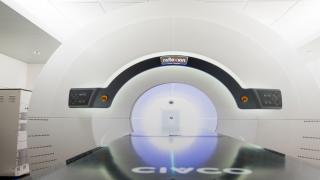City of Hope has treated its first patients using a novel radiation machine that one day might achieve the evasive goal of delivering tumor-destroying radiation in “real time” to multiple tumors. It could be a revolutionary step forward for people with advanced cancers who previously wouldn’t have been considered for such therapy.
“We were the second institution in the world to turn the radiation beam on and actually treat patients with this radiation device,” said Terence Williams, M.D., Ph.D., professor and chair of the Department of Radiation Oncology at City of Hope. “It’s an advanced machine, allowing us to see more tumors throughout the body.”
The device, built by Bay Area startup RefleXion, offers a broader ability to shape the radiation beamlets aimed at tumors and to account for body and organ movement, which can help doctors shape radiation dosages and exposures in ways that limit damage to surrounding tissue, said An Liu, Ph.D., clinical professor and director of the Division of Radiation Physics.
“In radiation oncology, we want to shape the beam so the tumor gets a high dose while the surrounding normal structure is getting a very low dose,” said Liu. “The more degrees of freedom we have in the beamlets, the better we can do that.”
RefleXion’s technology vastly speeds up the function of a complex device that shapes that radiation, known as a multileaf collimator, Liu said. “It moves super, super fast. Basically, it’s in the microsecond range. So the available beamlets to deliver radiation to tumors become pretty much infinite.”
Two patients, each with advanced metastatic cancer, began treatment in early August. One patient wasn’t a candidate for surgery, and surgery wasn’t quite enough for the other. Both are doing well after radiotherapy, Williams said.
Changing The Paradigm
While the milestone treatment method offers optimism both to patients and to Williams and Liu, the machine’s full therapeutic potential has yet to be fully explored. It awaits the results of several small trials to earn full approval from the Food and Drug Administration (FDA). That decision might come as early as next year, according to the company.
“If it works successfully, we’re talking about changing the paradigm of what we consider curable in the metastatic setting,” Williams said. “The classical thought with Stage 4 or metastatic cancers is that we generally can’t cure them with drugs, radiation or surgery.” In these instances, patients often have far too many tumors, which would require prohibitively high radiation exposure or a series of difficult surgeries and recovery periods.
The RefleXion X1 at City of Hope could potentially treat many tumors at once by overcoming what has long been a limit in radiotherapy: its powerful beams target images taken in the past of a disease that keeps running ahead, in a patient who likely is moving on the table, no matter how hard they try to keep still.
“People don’t realize that on the actual day of treatment, the patient’s anatomy can be different from a couple weeks ago,” Liu said. While imaging such as positron emission tomography (PET) can obtain highly accurate and timely images, the treatment plan ultimately rests on computer-generated anatomical models of where tumors are likely to be and where noncancerous tissue begins.
Scanning in Real Time
Stanford-educated electrical engineer Sam Mazin, Ph.D., approached Liu a decade ago with an idea to solve that limitation by using the real-time biological signals picked up by PET scanners to direct radiation right back at the tumor immediately. In other words, biology-guided radiotherapy (BgRT) instead of image-guided therapy.
“It’s like a racecar on a track,” said Mazin, now RefleXion’s chief technology officer. “The racecar can be anywhere on that track, and what a traditional machine might do is to illuminate the entire track to make sure they’re hitting the racecar.”
RefleXion’s technology is designed to be more like a spotlight on each car, regardless of its direction.
Rather than cobbling together images taken from various scanners as in conventional radiotherapy, in BgRT actual tumor cells absorb a radiotracer (a kind of glucose) and signal their presence to the onboard PET scanner “live.” They are then rapidly targeted for destruction by the super-precise radiation beams.
BgRT sounded good “on paper” when Mazin first described it to him in 2014, Liu said. But the physicist was skeptical that the linear accelerator that produces the radiation, the device that shapes its beams and the PET scanner could be moved and synchronized at the speeds needed to fire at multiple moving targets, all in the space occupied by current machines.
“At the beginning, I was not very optimistic that he could get funding and get it started,” Liu said. But Mazin found backers, and Liu was more impressed with detailed designs. City of Hope became a minority investor and sent staff to help Mazin finesse the design.
Solving the engineering challenges presented by BgRT helped improve more conventional treatments like the therapies the two patients received in August, Liu said. The speed at which beams can be shaped and aimed dropped to the level of seconds, when minutes were the standard, he said.
Already, City of Hope research has suggested that BgRT could offer a 20% reduction in the volume of lung cancer tissue that would need to be irradiated under the conventional standard of care, Mazin said.
The hospital also wants to design trials using different types of radioactive tracers beyond the one that the FDA is likely to approve.
Those and other research and treatment prospects excite Williams and Liu, who praised City of Hope for committing early to the developing technology. “The only way we can advance cancer cure is to participate, to be a pioneer in the field,” said Liu. “If we keep waiting for technology to mature before we engage, then we are followers, we’re not pioneers.”

